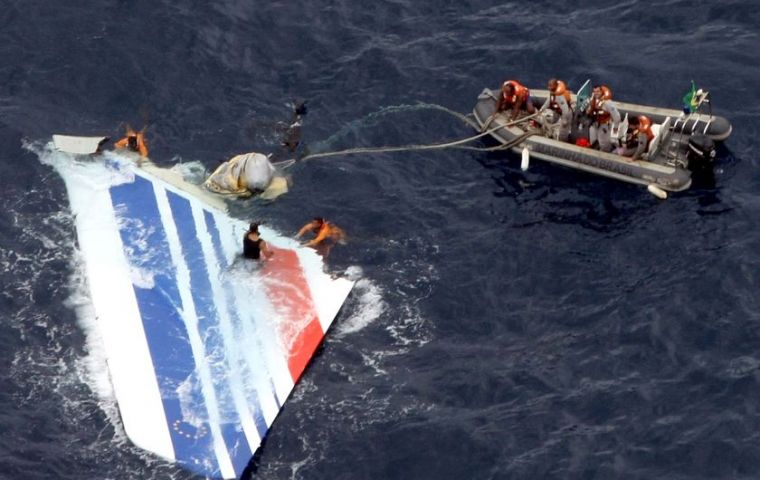MercoPress. South Atlantic News Agency
Air France flight 447 stalled and in three and a half minutes crashed into the Atlantic
 All indicates that the speed probes, since then changed in all other aircraft, failed
All indicates that the speed probes, since then changed in all other aircraft, failed The Air France jet which crashed into the Atlantic en route from Rio in 2009 stalled and fell in three and a half minutes, French investigators report. The air accident investigations bureau (BEA) found the crew had struggled with contradictory speed readings just before the plane crashed.
The BEA statement did not look at the causes of the crash but one theory is that the jet's speed probes failed. All 228 people on board were killed in the disaster.
The BEA findings were released in an online statement on response to speculation in the media over the findings from the flight recorders only recovered from the sea this month. A full report into the disaster is not expected until next year.
While cautioning against a rush to conclusions, Air France said on Friday that it appeared “the initial problem was the failure of the speed probes”.
Since the crash, the air line has replaced the speed, or Pitot, probes on its Airbus fleet with a newer model, AFP news agency reports.
Ahead of Friday's statement, the BEA said it wished to correct “partial and more or less contradictory information published in the media”.
It was giving “factual elements on the operation of the flight that... establish the circumstances of the accident but not the causes”.
Flight AF 447 went down on 1 June 2009 after running into an intense high-altitude thunderstorm, four hours into a flight from Rio de Janeiro in Brazil to Paris.
One of the instruments showed “a sharp fall” in air speed as the plane entered a zone of turbulence, the stall warning sounded and the autopilot and auto-thrust disengaged, the BEA said in its statement. As the plane slowed, it climbed to 11,600m.
At the time, the captain was taking a routine rest, with the two co-pilots in control in the cockpit. As the co-pilots struggled to understand what had happened, the captain returned but did not retake control.
For a period of less than a minute, speeds displayed on the left primary flight display were inconsistent with those on the integrated standby instrument system, the BEA found.
French investigators have been working on the theory that the speed probes malfunctioned because of ice at high altitude. This may have set off an unpredictable chain of events.
According to the data released by the BEA, the captain was back in the cockpit two minutes and 48 seconds before the crash. Investigators found the composition of the crew had been “in accordance with the operator's procedures”.
Air France praised Captain Marc Dubois and his co-pilots, Pierre-Cedric Bonin and David Robert, as “three skilled pilots” who had “demonstrated a totally professional attitude and were committed to carrying out their task to the very end”.
Those on board the jet came from more than 30 countries, though most were French, Brazilian or German. The wreckage of the plane was discovered after a long search of 10,000 sq km of sea floor.




Top Comments
Disclaimer & comment rulesCommenting for this story is now closed.
If you have a Facebook account, become a fan and comment on our Facebook Page!